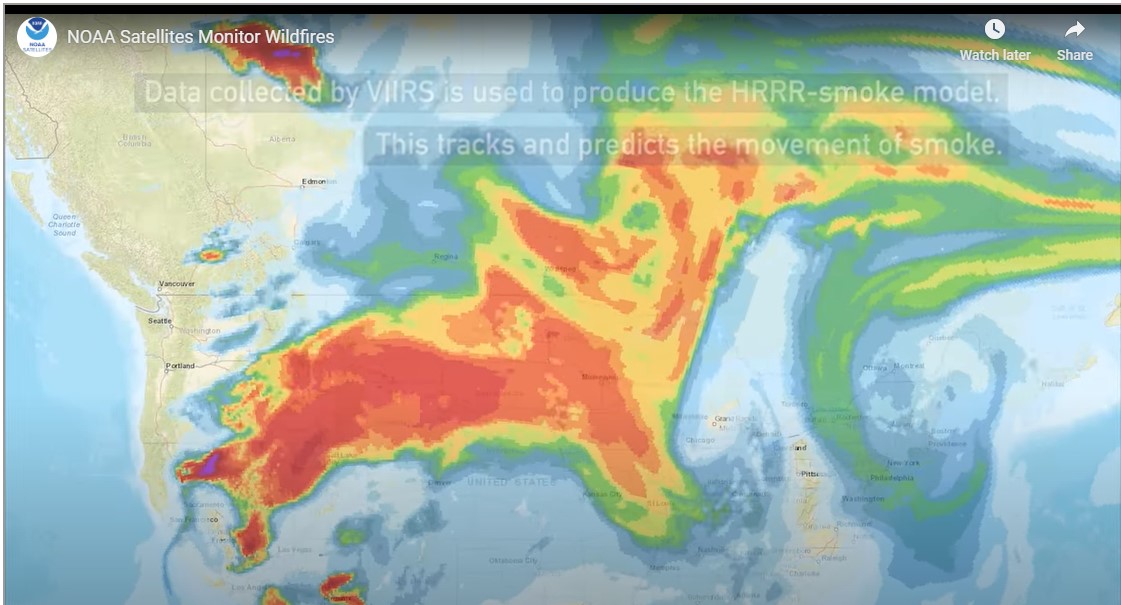
Smoke rises above the roadway as the Park Fire jumps Highway 36 near Paynes Creek in Tehama County, Calif., on July 26. Photo: Noah Berger/AP
Smoke Gets in Your Eyes by the Platters was number #1 on the charts in 1959 “. . .when your heart’s on fire, You must realize smoke gets in your eyes.”
Wildfire smoke contains large amounts of carbon dioxide, black carbon, brown carbon and ozone precursors. All are released into the atmosphere.
These emissions affect radiation, clouds and climate on regional and even global scales, according to NOAA (National Oceanic and Atmospheric Administration). The release of carbon dioxide into the atmosphere contributes to climate change.
NOAA notes that the combination of a warmer, drier climate with the fire-control practices that were in place over the last century has produced a situation in which we can expect more frequent fires and fires of larger magnitude in the U.S. West and Canada.
Fire suppression practices have led to a buildup of fuels in forests, a breakdown in natural forest ecology, and increased risk at urban wildland boundaries.
According to UC Davis Environmental Health Sciences Center “wildfires affect every aspect of life and wildfires are a global threat.”
Areas of high-severity fire can impact tree generation, soil erosion and water quality, according to the California Department of Fish and Wildlife.
A reader properly chastised this editor for complaining that the smoke from California and Oregon fires were contributing to unhealthy air in Wyoming and South Dakota.
My South Dakota mom, 95, was having problems breathing because of the smoke that travels from west to east. According to the Environmental Protection Agency (EPA), most fire deaths are not caused by burns, but by smoke inhalation.
The Palisades reader wrote, “I returned a week ago from Montana, where 19 separate fires were burning at that time, causing hazy skies throughout Glacier National Park. There were also multiple fires in Washington state. Today there are four fires burning in Colorado and at least one in Utah. And, as of today, there are several fires in Wyoming.”
If you go to the Western Fire Chiefs map, you can see where the fires are currently, the size and the percentage contained. https://wfca.com/fire-map It appears that California and Oregon have the largest fires in acreage size, with the least amount of containment.
“Seems to me that it isn’t just California and Oregon that are burning,” the reader continued. “Let’s be fair. Smoke pollution travels far, can move across oceans and continents (ash from Australia’s horrific fires of 2019 fell on New Zealand’s South Island, 2000 miles away, which we observed that year dusting the glaciers.) Let’s have constructive conversations about how to mitigate the dangers, not point fingers and ‘other’ people or states we don’t like.”
What can be done? Currently, CalFire is working with a few prevention programs that include fuels reduction, prescribed fire burns and vegetation management. In January 2021, California’s Wildfire and Forest Resilience Action Plan was implemented. click here.
In the introduction of the plan, it was noted: “California is facing a growing forest and wildfire crisis. Decades of fire suppression, coupled with the increasing impacts of climate change, have dramatically increased wildfires’ size and intensity throughout the state.
“The 2020 fire season broke numerous records. Five of California’s six largest fires in modern history burned at the same time, destroying thousands of buildings, forcing hundreds of thousands of people to flee their homes, and exposing millions of residents to dangerously unhealthy air. More than four million acres burned across the state, double the previous record.”
The purple spot is the Park Fire and NOAA uses satellites to predict the direction of the smoke click here.


People think pristine air is the natural, default condition of our skies. And after the rains it is. But the government and tribes should be doing more in the way of controlled burns to keep the fire temperatures low. 100 years of fuel accumulation via suppression and 50 years of low logging intensity results in fires that kill the trees instead of thinning and clearing the underbrush.
Don’t forget all the fires in Canada. Some of them have been burning since last year. Also fires in Colorado and in New Mexico. There really is no place with trees and brush that can escape. Even Nevada was hit during the recent terrible heat waves. Not only do we need to learn better care of our wildlands we are going to have to learn to live with the continued prospect of dreadful high temperatures where any and everything can burn quickly. Perhaps soon people will accept that our previous good weather patterns have changed and we are in a new era, accelerated by our own careless and disdainful attitudes toward our planet.
Part of the problem is the forestry/government have forbidden any kind of burns, which used to be routine in nature. Now they seem to be permitting prescribed burns–maybe careful logging should also resume.